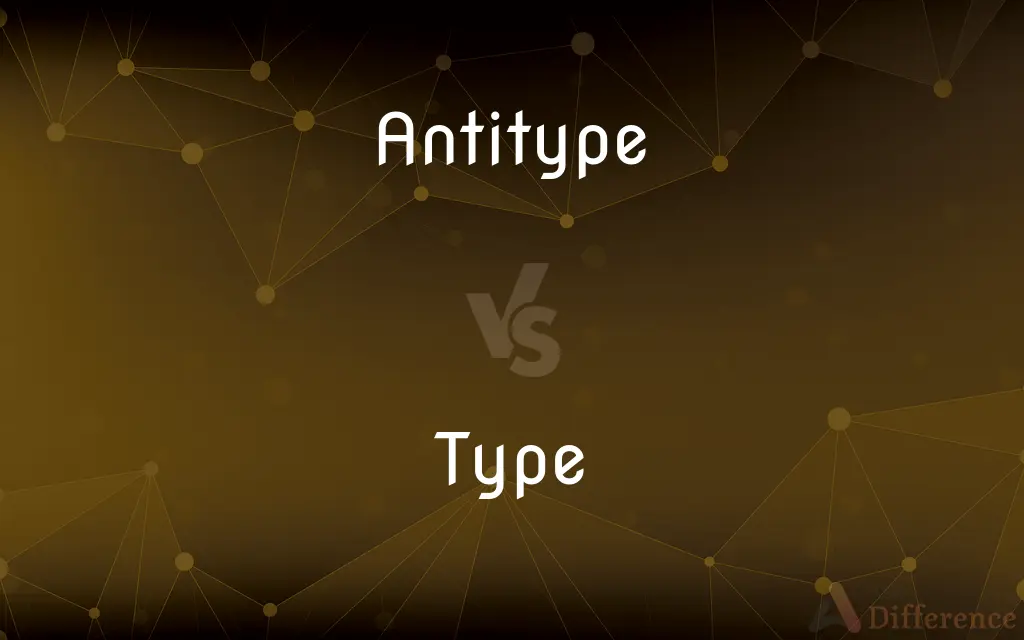Antitype vs. Type — What's the Difference?
By Maham Liaqat & Fiza Rafique — Updated on April 5, 2024
A type is a symbolic representation or example that prefigures and foreshadows future events or persons, used in theology and literature, while an antitype is fulfillment or realization of these symbols, providing the concrete embodiment of earlier type.

Difference Between Antitype and Type
Table of Contents
ADVERTISEMENT
Key Differences
In religious and literary contexts, a type serves as a predictive symbol, a figure or event in the Old Testament, for instance, that anticipates and foreshadows a future figure or event, often found in the New Testament. This typological interpretation helps bridge past and future, suggesting a preordained design or pattern. An antitype, on the other hand, is the fulfillment or actualization of the type. It is the concrete instance that the type pointed towards, providing a deeper understanding and completion of the symbolic narrative.
The relationship between type and antitype is foundational in typology, especially in Christian theology, where it illuminates the connections between the Old and New Testaments. Types are seen as intentional prefigurations set by God to indicate future events, such as the sacrifice of Isaac being a type of the crucifixion of Jesus Christ. Antitypes, then, are the culmination of these divine hints, the events or figures that complete and clarify the initial symbols.
In literature, this concept is used to analyze narrative structures and character archetypes, where a type might represent an abstract concept or a thematic element that recurs across different works or within a single work in various forms. The antitype, in this context, would be the specific instance that embodies and enhances the understanding of the recurring theme or concept, providing insight into the narrative or thematic development.
Types often operate on the level of metaphor or allegory, inviting contemplation and interpretation, offering a lens through which the significance of historical events or literary narratives can be viewed. Antitypes, by fulfilling these symbolic anticipations, not only validate the initial symbols but also enrich the narrative or theological message, offering a resolution or fulfillment that deepens the overall meaning.
The interplay between type and antitype emphasizes the continuity and coherence within texts, be they religious scriptures or literary works, suggesting that events or characters are part of a larger, often divinely inspired, narrative. This connection reinforces the idea of a deliberate and meaningful design underlying the progression from type to antitype, illuminating the significance of both in understanding the overarching message or theme.
ADVERTISEMENT
Comparison Chart
Definition
The fulfillment or realization of a type
A symbolic representation foreshadowing future events or figures
Context
Seen as the concrete embodiment or completion of the type
Often used in religious texts and literature to represent abstract concepts or future occurrences
Function
To fulfill and clarify the symbolism of the type
To prefigure and anticipate future events or figures in a symbolic manner
Usage in Theology
Refers to New Testament figures or events that fulfill Old Testament symbols
Represents figures or events in the Old Testament that foreshadow New Testament realities
Literary Significance
Acts as the narrative or thematic culmination that validates and deepens the type’s significance
Serves as a thematic or metaphorical device to suggest future narrative developments or thematic resolutions
Compare with Definitions
Antitype
A symbolic prefiguration found in earlier texts or events.
Jonah's three days in the whale is a type of Christ's three days in the tomb.
Type
A symbolic prefiguration found in earlier texts or events.
Jonah's three days in the whale is a type of Christ's three days in the tomb.
Antitype
An example that foreshadows a future event or person.
The Passover lamb is a type of the sacrifice of Christ.
Type
A narrative device that anticipates future developments.
The fall of Icarus is a type of hubris leading to downfall.
Antitype
Represents abstract concepts through specific figures or events.
The ark is a type of the Church.
Type
An example that foreshadows a future event or person.
The Passover lamb is a type of the sacrifice of Christ.
Antitype
Used to illustrate conceptual or thematic elements in literature.
The journey in the wilderness is a type of the spiritual journey.
Type
Used to illustrate conceptual or thematic elements in literature.
The journey in the wilderness is a type of the spiritual journey.
Antitype
A narrative device that anticipates future developments.
The fall of Icarus is a type of hubris leading to downfall.
Type
Represents abstract concepts through specific figures or events.
The ark is a type of the Church.
Antitype
One that is foreshadowed by or identified with an earlier symbol or type, such as a figure in the New Testament who has a counterpart in the Old Testament.
Type
A person or thing exemplifying the ideal or defining characteristics of something
She characterized his witty sayings as the type of modern wisdom
Antitype
An opposite or contrasting type.
Type
Characters or letters that are printed or shown on a screen
Bold type
Antitype
Something that is symbolized or represented by a type, such as Christ by the Paschal Lamb; the fulfillment of a type.
Type
A design on either side of a medal or coin.
Antitype
A type that represents the opposite or antagonist of another type.
Type
An abstract category or class of linguistic item or unit, as distinct from actual occurrences in speech or writing.
Antitype
That of which the type is the pattern or representation; that which is represented by the type or symbol.
Type
Write (something) on a typewriter or computer by pressing the keys
He typed out the second draft
I'm learning to type
Antitype
A person or thing represented or foreshadowed by a type or symbol; especially a figure in the Old Testament having a counterpart in the New Testament
Type
A number of people or things having in common traits or characteristics that distinguish them as a group or class:That type of car was popular in the 1970s. See Synonyms at kind.
Antitype
An opposite or contrasting type
Type
A person or thing having the features of a group or class:He is the type of person that is bound to get into trouble.
Type
An example or a model having the ideal features of a group or class; an embodiment:"He was the perfect type of a military dandy"(Joyce Cary).
Type
A person regarded as exemplifying a particular profession, rank, or social group:a group of executive types; a restaurant frequented by tourist types.
Type
A figure, representation, or symbol of something to come, such as an event in the Old Testament that is believed to foreshadow another in the New Testament.
Type
(Biology)The type specimen, type species, or type genus, which serves as the basis for the name of a species, genus, or family.
Type
A small block of metal or wood bearing a raised letter or character on the upper end that leaves a printed impression when inked and pressed on paper.
Type
Such pieces considered as a group.
Type
Printed or typewritten characters; print:Let's see how your letter looks in type.
Type
A size or style of printed or typewritten characters; a typeface:a sans-serif type.
Type
A pattern, a design, or an image impressed or stamped onto the face of a coin.
Type
To write (something) using a typewriter.
Type
To input (something) manually on an electronic device, especially by using a keyboard.
Type
To assign to a category; classify or characterize:a political candidate who was typed as indecisive.
Type
To typecast:an actor afraid of being typed as a gangster.
Type
To write with a typewriter or computer keyboard.
Type
A grouping based on shared characteristics; a class.
This type of plane can handle rough weather more easily than that type of plane.
Type
An individual considered typical of its class, one regarded as typifying a certain profession, environment, etc.
Type
An individual that represents the ideal for its class; an embodiment.
Type
A letter or character used for printing, historically a cast or engraved block.
Type
(uncountable) Such types collectively, or a set of type of one font or size.
Type
Text printed with such type, or imitating its characteristics.
The headline was set in bold type.
Type
(taxonomy) Something, often a specimen, selected as an objective anchor to connect a scientific name to a taxon; this need not be representative or typical.
Type
Preferred sort of person; sort of person that one is attracted to.
We can't get along: he's just not my type.
He was exactly her type.
Type
(corpus linguistics) A word that occurs in a text or corpus irrespective of how many times it occurs, as opposed to a token.
Type
(theology) An event or person that prefigures or foreshadows a later event - commonly an Old Testament event linked to Christian times.
Type
(computing theory) A tag attached to variables and values used in determining which kinds of value can be used in which situations; a data type.
Type
(fine arts) The original object, or class of objects, scene, face, or conception, which becomes the subject of a copy; especially, the design on the face of a medal or a coin.
Type
(chemistry) A simple compound, used as a mode or pattern to which other compounds are conveniently regarded as being related, and from which they may be actually or theoretically derived.
The fundamental types used to express the simplest and most essential chemical relations are hydrochloric acid, water, ammonia, and methane.
Type
(mathematics) A part of the partition of the object domain of a logical theory (which due to the existence of such partition, would be called a typed theory). (Note: this corresponds to the notion of "data type" in computing theory.)
Categorial grammar is like a combination of context-free grammar and types.
Type
A symbol, emblem, or example of something.
Type
To put text on paper using a typewriter.
Type
To enter text or commands into a computer using a keyboard.
Type
To represent by a type, model, or symbol beforehand; to prefigure.
Type
To furnish an expression or copy of; to represent; to typify.
Type
To categorize into types.
Type
The mark or impression of something; stamp; impressed sign; emblem.
The faith they have in tennis, and tall stockings,Short blistered breeches, and those types of travel.
Type
Form or character impressed; style; semblance.
Thy father bears the type of king of Naples.
Type
A figure or representation of something to come; a token; a sign; a symbol; - correlative to antitype.
A type is no longer a type when the thing typified comes to be actually exhibited.
Type
That which possesses or exemplifies characteristic qualities; the representative.
Since the time of Cuvier and Baer . . . the whole animal kingdom has been universally held to be divisible into a small number of main divisions or types.
Type
The original object, or class of objects, scene, face, or conception, which becomes the subject of a copy; esp., the design on the face of a medal or a coin.
Type
A raised letter, figure, accent, or other character, cast in metal or cut in wood, used in printing.
Type
A simple compound, used as a model or pattern to which other compounds are conveniently regarded as being related, and from which they may be actually or theoretically derived.
Type
To represent by a type, model, or symbol beforehand; to prefigure.
Type
To furnish an expression or copy of; to represent; to typify.
Let us type them now in our own lives.
Type
A subdivision of a particular kind of thing;
What type of sculpture do you prefer?
Type
A person of a specified kind (usually with many eccentricities);
A real character
A strange character
A friendly eccentric
The capable type
A mental case
Type
(biology) the taxonomic group whose characteristics are used to define the next higher taxon
Type
Printed characters;
Small type is hard to read
Type
A small metal block bearing a raised character on one end; produces a printed character when inked and pressed on paper;
He dropped a case of type, so they made him pick them up
Type
All of the tokens of the same symbol;
The word `element' contains five different types of character
Type
Write by means of a keyboard with types;
Type the acceptance letter, please
Type
Identify as belonging to a certain type;
Such people can practically be typed
Common Curiosities
How do types and antitypes contribute to literary analysis?
They offer a framework for understanding thematic and narrative development, revealing deeper meanings and connections within texts.
What is the purpose of types and antitypes in theology?
They illustrate the continuity and fulfillment of divine promises or prophesies, bridging Old and New Testament narratives.
Can a figure or event be both a type and an antitype?
Yes, a figure or event can serve as a type for one event and an antitype for another, depending on the context and interpretation.
Can antitypes exist without types?
Conceptually, antitypes are defined in relation to types; without a type to fulfill, the notion of an antitype doesn't apply.
Do all theologians agree on what constitutes a type and an antitype?
Interpretations can vary among theologians, reflecting different theological perspectives and hermeneutical approaches.
How do types and antitypes affect the interpretation of scripture?
They encourage a deeper, more interconnected reading of scriptures, highlighting the coherence and unity of biblical narratives.
Are types and antitypes exclusive to Christian theology?
While especially prominent in Christian theology, the concept can apply to any narrative structure that involves foreshadowing and fulfillment.
How are types and antitypes identified in the Bible?
Through study and interpretation, considering the thematic, historical, and prophetic links between Old and New Testament passages.
Can types and antitypes be misinterpreted?
Yes, subjective interpretation can lead to debates over what constitutes a valid typological connection.
Is there a limit to how many antitypes a type can have?
Conceptually, no; a type can have multiple antitypes, depending on the breadth of its symbolic significance and interpretative scope.
How do types and antitypes enrich the reading of literature?
They add layers of meaning, allowing readers to see beyond the surface narrative to the thematic or symbolic resonance within the text.
How does one distinguish a type from a simple foreshadowing?
A type has a deeper symbolic or prophetic significance, often recognized in hindsight, beyond mere narrative foreshadowing.
Share Your Discovery

Previous Comparison
Final vs. Finals
Next Comparison
Peg vs. ClothespinAuthor Spotlight
Written by
Maham LiaqatCo-written by
Fiza RafiqueFiza Rafique is a skilled content writer at AskDifference.com, where she meticulously refines and enhances written pieces. Drawing from her vast editorial expertise, Fiza ensures clarity, accuracy, and precision in every article. Passionate about language, she continually seeks to elevate the quality of content for readers worldwide.













































